Alcatraz Island () is a small island 1.25 miles (2.01 km) offshore from San Francisco, California, United States. The island was developed in the mid-19th century with facilities for a lighthouse, a military fortification, and a military prison. In 1934, the island was converted into a federal prison, Alcatraz Federal Penitentiary. The strong currents around the island and cold water temperatures made escape nearly impossible, and the prison became one of the most notorious in American history. The prison closed in 1963, and the island is now a major tourist attraction.
Beginning in November 1969, the island was occupied for more than 19 months by a group of Native Americans, initially primarily from San Francisco, who were later joined by AIM and other urban Indians from other parts of the country, who were part of a wave of Native American activists organizing public protests across the US through the 1970s. In 1972, Alcatra...Read more
Alcatraz Island () is a small island 1.25 miles (2.01 km) offshore from San Francisco, California, United States. The island was developed in the mid-19th century with facilities for a lighthouse, a military fortification, and a military prison. In 1934, the island was converted into a federal prison, Alcatraz Federal Penitentiary. The strong currents around the island and cold water temperatures made escape nearly impossible, and the prison became one of the most notorious in American history. The prison closed in 1963, and the island is now a major tourist attraction.
Beginning in November 1969, the island was occupied for more than 19 months by a group of Native Americans, initially primarily from San Francisco, who were later joined by AIM and other urban Indians from other parts of the country, who were part of a wave of Native American activists organizing public protests across the US through the 1970s. In 1972, Alcatraz was transferred to the Department of Interior to become part of Golden Gate National Recreation Area. It was designated as a National Historic Landmark in 1986.
Today, the island's facilities are managed by the National Park Service as part of Golden Gate National Recreation Area. Visitors can reach the island by ferry ride from Pier 33, located between the San Francisco Ferry Building and Fisherman's Wharf, San Francisco. Hornblower Cruises, operating under the name Alcatraz Cruises, is the official ferry provider to and from the island.
Alcatraz Island is the site of the abandoned federal prison, the oldest operating lighthouse on the West Coast of the United States, early military fortifications, and natural features such as rock pools and a seabird colony (mostly western gulls, cormorants, and egrets). According to a 1971 documentary on the history of Alcatraz, the island measures 1,675 feet (511 m) by 590 feet (180 m) and is 135 feet (41 m) at highest point during mean tide. The total area of the island is reported to be 22 acres (8.9 ha).
Landmarks on the island include the Main Cellhouse, Dining Hall, Lighthouse, the ruins of the Warden's House and Social Hall, Parade Grounds, Building 64, Water Tower, New Industries Building, Model Industries Building, and the Recreation Yard.
 Alcatraz Island, 1896
Alcatraz Island, 1896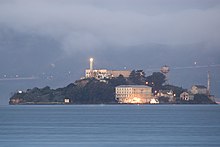 Alcatraz in the dawn mist, from the east. The "parade ground" is at left.
Alcatraz in the dawn mist, from the east. The "parade ground" is at left. Alcatraz Island and lighthouse at sunset
Alcatraz Island and lighthouse at sunset The water tower and powerhouse (at right), which generated electricity for the island
The water tower and powerhouse (at right), which generated electricity for the island A model of Military Point Alcatraz, 1866–1868, now on display at Alcatraz Island
A model of Military Point Alcatraz, 1866–1868, now on display at Alcatraz Island Model of the prison in present day, on display at Alcatraz Island
Model of the prison in present day, on display at Alcatraz IslandThe first European to document the islands of San Francisco Bay was Spanish naval officer and explorer Juan Manuel de Ayala during Spanish rule of California; he charted San Francisco Bay in 1775. He named today's Yerba Buena Island as "La Isla de los Alcatraces", which translates as "The Island of the Gannets" but is commonly believed to translate as "The Island of the Pelicans" (the modern Spanish word for 'pelican' is pelícano),[1][2][3][4][5][6] from the archaic Spanish alcatraz ("pelican"). There are no gannets native to the Pacific coast, making the older Spanish usage more likely.
Yerba Buena Island was labeled on Ayala's 1775 chart of San Francisco Bay as "Isla de Alcatraces". The name was later applied to the rock now known as Alcatraz Island by Captain Frederick W. Beechey, an English naval officer and explorer.[7]
Over the years, the Spanish version "Alcatraz" became popular and is now widely used. In August 1827, for instance, French Captain Auguste Bernard Duhaut-Cilly wrote "... running past Alcatraze's (Pelicans) Island ... covered with a countless number of these birds. A gun fired over the feathered legions caused them to fly up in a great cloud and with a noise like a hurricane."[8] The California brown pelican (Pelecanus occidentalis californicus) is not known to nest on the island today. The Spanish built several small buildings on the island and other minor structures.[9]
Fort AlcatrazThe earliest recorded private owner of the island of Alcatraz is Julian Workman, to whom it was given by Mexican governor Pio Pico in June 1846, with the understanding that Workman would build a lighthouse on it.[10] Julian Workman is the baptismal name of William Workman, co-owner of Rancho La Puente and a personal friend of Pio Pico. Later in 1846, acting in his capacity as Military Governor of California, John C. Frémont bought the island for $5,000 in the name of the United States government from Francis Temple.[9][11][12]
In 1850, President Millard Fillmore ordered that Alcatraz Island be set aside specifically as a United States military reservation,[5] for military purposes based upon the U.S. acquisition of California from Mexico following the Mexican–American War.[13] Frémont had expected a large compensation for his initiative in purchasing and securing Alcatraz Island for the U.S. government, but the U.S. government later invalidated the sale and paid Frémont nothing. Frémont and his heirs sued for compensation during protracted but unsuccessful legal battles that extended into the 1890s.[13]
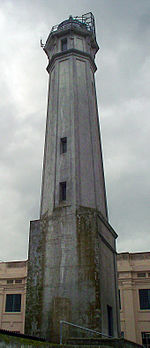 The lighthouse tower adjacent to the prison cell house
The lighthouse tower adjacent to the prison cell houseFollowing the acquisition of California by the United States as a result of the Treaty of Guadalupe Hidalgo (1848), which ended the Mexican–American War, and the onset of the California Gold Rush the following year, the U.S. Army began studying the suitability of Alcatraz Island for the positioning of coastal batteries to protect the approaches to San Francisco Bay. In 1853, under the direction of Zealous B. Tower, the United States Army Corps of Engineers began fortifying the island, work which continued until 1858, when the initial version of Fort Alcatraz was complete. The island's first garrison, numbering about 200 soldiers, arrived at the end of that year.
When the American Civil War broke out in 1861, the island mounted 85 cannons (increased to 105 cannons by 1866) in casemates around its perimeter, though the small size of the garrison meant only a fraction of the guns could be used at one time. At this time it also served as the San Francisco Arsenal for storage of firearms to prevent them falling into the hands of Confederate sympathizers.[14] Alcatraz, built as a "heavily fortified military site on the West Coast", was to form a "triangle of defense" with Fort Point and Lime Point, but the contemplated work on Lime Point was never built. The first operational lighthouse on the West Coast of the United States was also built on Alcatraz. During the war, Fort Alcatraz was used to imprison Confederate sympathizers and privateers on the west coast, but its guns were never fired at an enemy.[15]
Studies of the island and its fortifications have included archeological surveys relying on contemporary technology. In 2019 "Binghamton University archaeologist Timothy de Smet and colleagues located historical remains beneath the former recreation yard of the Alcatraz Federal Penitentiary." Using ground-penetrating radar (GPR) data and georectifications, Smet and colleagues discovered structures, including "a 'bombproof' earthwork traverse along with its underlying vaulted brick masonry tunnel and ventilation ducts," in surprisingly good condition.[16] Archaeologists also found the remains of ammunition magazines, and tunnels below the penitentiary that was built later.[17][18]
Because of the isolation created by the cold, strong currents of the waters of San Francisco Bay, as early as 1859, Alcatraz was used to house soldiers convicted of crimes. By 1861, the fort was the military prison for the Department of the Pacific. It housed Civil War prisoners of war (POWs) as early as that year.[citation needed]
 Alcatraz citadel built in the early 1850s; 1908 photo
Alcatraz citadel built in the early 1850s; 1908 photoStarting in 1863, the military also held private citizens accused of treason, after the writ of habeas corpus in the United States was suspended. Hundreds of troops were trained on the island, with more than 350 military personnel in place by April 1861. As enlistees were assigned to units, new green troops reported for training. In early 1865, the number of men reached 433, the peak of the war.[19]
During the Civil War-era, rapid changes in artillery and fortification were generated. Alcatraz's defenses were obsolete by the postwar years. Modernization efforts, including an ambitious plan to level the entire island and construct shell-proof underground magazines and tunnels, were undertaken between 1870 and 1876 but never completed (the so-called "parade ground" on the southern tip of the island represents the extent of the flattening effort).[20] Instead, the army switched the focus of its plans for Alcatraz from coastal defense to detention, a task for which it was well suited because of its isolation.
In 1867, a brick jailhouse was built (previously inmates had been kept in the basement of the guardhouse), and in 1868, Alcatraz was officially designated as a long-term detention facility for military prisoners. The facility was later discontinued for Prisoners of War in 1846[dubious ]. Among those incarcerated at Alcatraz were Confederates caught on the West Coast[9] and some Hopi Native American men in the 1870s, who refused orders to send their children away from their families to Indian boarding schools.[21]
In 1898, due to the Spanish–American War, the prison population rose from 26 to over 450. From 1905 to 1907 it was commanded by U.S. Army General George W. McIver. After the 1906 San Francisco earthquake, civilian prisoners were transferred to Alcatraz for safe confinement. On March 21, 1907, Alcatraz was officially designated as the Western U.S. Military Prison, later Pacific Branch, U.S. Disciplinary Barracks, 1915.[14]
In 1909 construction began on the huge concrete main cell block, designed by Major Reuben Turner, which remains the island's dominant feature. It was completed in 1912.[14] To accommodate the new cell block, the Citadel, a three-story barracks, was demolished down to the first floor, which was below ground level. The building had been constructed in an excavated pit, creating a defensive dry moat. The first floor was incorporated as a basement to the new cell block, giving rise to the popular legend of "dungeons" below the main cell block. The US Disciplinary Barracks was deactivated in October 1933 and transferred to the Bureau of Prisons.[14]
During World War I, the prison was used to hold conscientious objectors, including Philip Grosser, who wrote a pamphlet entitled Uncle Sam's Devil's Island about his experiences.[22]
Alcatraz Federal Penitentiary An exterior view of the Alcatraz main cell block from the exercise yard
An exterior view of the Alcatraz main cell block from the exercise yardThe United States Disciplinary Barracks on Alcatraz were acquired by the United States Department of Justice on October 12, 1933, and the island was designated as a federal prison in August 1934. Alcatraz was designed to hold prisoners who continuously caused trouble at other federal prisons.[23] At 9:40 am on August 11, 1934, the first batch of 137 prisoners arrived at Alcatraz, arriving by railroad from the United States Penitentiary in Leavenworth, Kansas, to Santa Venetia, California. They were escorted to Alcatraz, while handcuffed in high security coaches and guarded by 60 special FBI agents, U.S. Marshals and railway security officials.[9][24]
Most of the prisoners were notorious bank robbers and murderers.[9] The prison initially had a staff of 155, including the first warden James A. Johnston and associate warden J. E. Shuttleworth, both considered to be "iron men".[9] The staff were highly trained in security, but not rehabilitation.[9]
 Cell 281 in Alcatraz where Al Capone was imprisoned
Cell 281 in Alcatraz where Al Capone was imprisonedDuring the 29 years it was in use, the prison held some of the most notorious criminals in American history,[9] including gangsters such as Al Capone, Robert Franklin Stroud (the "Birdman of Alcatraz"), George "Machine Gun" Kelly and Bumpy Johnson, and political terrorists such as Rafael Cancel Miranda, a member of the Puerto Rican Nationalist Party who attacked the United States Capitol building in 1954.[25] Others included Mickey Cohen, Arthur R. "Doc" Barker, and Alvin "Creepy" Karpis, who served more time at Alcatraz than any other inmate. It also provided housing for the Bureau of Prisons staff and their families.
Contrary to popular belief, it was possible to escape and swim all of the way to shore.[26] However, during its 29 years of operation, the penitentiary claimed that no prisoner successfully escaped. A total of 36 prisoners made 14 escape attempts, two men trying twice. 23 were caught alive, six were shot and killed during their escape, two drowned, and five are listed as "missing and presumed drowned".[27] The most violent incident occurred on May 2, 1946, when a failed escape attempt by six prisoners led to the Battle of Alcatraz. Perhaps the most famous is the intricate escape, carried out on June 11, 1962, by Frank Morris, John Anglin, and Clarence Anglin. The three men are believed to have drowned in their attempt.
Although most escapees were caught or drowned, in 1962, prisoner John Paul Scott made it to the shore. However, he was so weary that police found him unconscious and in hypothermic shock. The annual Escape from Alcatraz Triathlon includes a required 1.5-mile (2.4 km) swim from the island to the bay shore.[28]
Closing of the prisonThere are several reasons that Alcatraz closed as a penitentiary in 1963. The penitentiary cost much more to operate than other prisons (nearly $10 per prisoner per day, as opposed to $3 per prisoner per day at Atlanta).[29] Half a century of salt water saturation had severely eroded the buildings and three people had purportedly escaped in 1962. After its closure, George Moscone received public proposals to repurpose Alcatraz Island.[30]
Native American occupation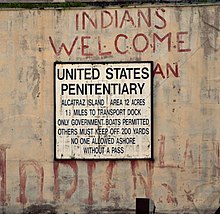 A lingering sign of the 1969–71 Native American occupation
A lingering sign of the 1969–71 Native American occupationAlcatraz Island was occupied by Native American activists for the first time on March 8, 1964. The protest, proposed by Lakota Sioux activist Belva Cottier and joined by about 35 others, was reported by, among others, the San Francisco Chronicle and the San Francisco Examiner.[31]
Beginning on November 20, 1969, a group of Native Americans called United Indians of All Tribes, mostly college students from San Francisco, occupied the island to protest federal policies related to American Indians. Some of them were children of Native Americans who had relocated in the city as part of the Bureau of Indian Affairs' (BIA) Indian termination policy, which was a series of laws and policies aimed at the assimilation of Native Americans into mainstream US society. It encouraged Native Americans to move away from the Indian reservations and into cities to take advantage of health, educational and employment opportunities. A number of employees of the Bureau of Indian Affairs also occupied Alcatraz at that time, including Doris Purdy, an amateur photographer, who later produced footage of her stay on the island.[32]
The occupiers, who stayed on the island for nearly two years, demanded that the island's facilities be adapted and new structures built for an Indian education center, ecology center, and cultural center. The American Indians claimed the island by provisions of the Treaty of Fort Laramie (1868) between the US and the Sioux; they said the treaty promised to return all retired, abandoned, or out-of-use federal lands to the native peoples from whom they were acquired. Indians of All Tribes claimed Alcatraz Island by the "Right of Discovery"; as historian Troy R. Johnson states in The Occupation of Alcatraz Island, generations of indigenous peoples knew about Alcatraz at least 10,000 years before any European knew about any part of North America. Begun by urban Indians of San Francisco, the occupation attracted other Native Americans from across the country, including American Indian Movement (AIM) urban activists from Minneapolis.
 The Alcatraz cellhouse, lighthouse, and Warden's House, which was burned out during the 1969–71 Native American occupation
The Alcatraz cellhouse, lighthouse, and Warden's House, which was burned out during the 1969–71 Native American occupationDuring the nineteen months and nine days of occupation by the American Indians, several buildings at Alcatraz were damaged or destroyed by fire, including the lighthouse keeper's home, the warden's home, the Officers' Club,[33] the recreation hall, and the Coast Guard quarters. The origin of the fires is disputed. The US government demolished a number of other buildings (mostly apartments) after the occupation had ended. Graffiti from the period of Native American occupation is still visible at many locations on the island.[34]
During the occupation, President Richard Nixon rescinded the Indian termination policy, designed by earlier administrations to end federal recognition of many tribes and their special relationship with the US government. He established a new policy of self-determination, in part as a result of the publicity and awareness created by the occupation. The occupation ended on June 11, 1971.[35]
Alcatraz under the National Park ServiceIn 1972, the National Park Service purchased Alcatraz along with Fort Mason from the U.S. Army to establish the Golden Gate National Recreation Area. Under "An Act to Establish the Golden Gate National Recreation Area" President Richard Nixon allocated $120 million for land acquisition and development of the area.[36] It has since been under the direction of the Golden Gate National Recreation Area and now operates as a tourist site and museum dedicated to its time as a federal penitentiary. Operating costs still remain one of its biggest challenges today.


















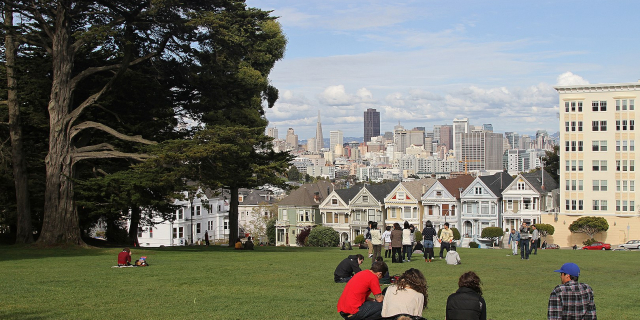



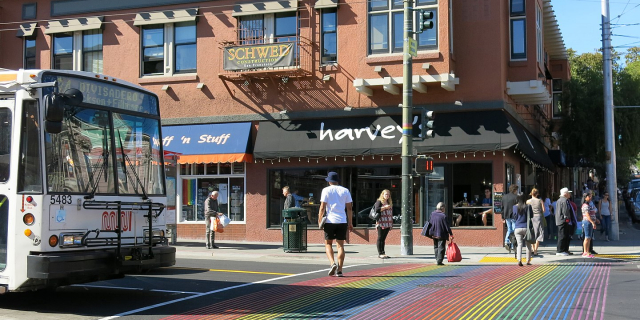












Add new comment